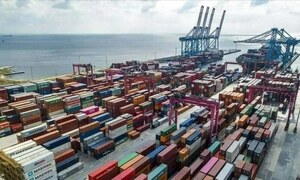Germany is a nation of chocolate-lovers, but they don't have to dig too deep in their pockets to feed their sweet tooth. That could change with the price of cocoa and other ingredients on the rise. Stuttgart (dpa) - The yo-yoing cost of commodities has left many of Germany's chocolate makers struggling to keep down the price of their product. The cost of ingredients such as cocoa, hazelnuts and almonds is hard to predict and 2015 is proving to be a particularly hard year for chocolate companies.
The price of cocoa climbed in July to its highest rate in four years before dipping slightly in August. German-based creators of Lindt chocolate, Lindt Spruengli, recently described the trend as a "massive price hike," with the commodities market still very volatile.
Rising costs have already hit the shelves in Austrian shops for fans of Lindt chocolate, with the company applying "selected price increases to certain products" in 2015, according to a spokeswoman. Now the brand's competitors are also reconsidering the price of their products. Nevertheless, Lindt says it has managed to keep prices down by boosting production line efficiency and increasing output in order to "absorb the price hikes in the commodities markets."
"The drastically increased cost of commodities, energy and logistics as well as increased wages could lead to higher prices which as a rule must reach the consumer," the German Confectionary Industry Association (BDSI) said in response to growing concerns. But BDSI chief Torben Erbrath also said the issue would be decided on by competition. Multinational brands like Nestle and Mondelez, which produces Milka chocolate, have kept a tight lip on whether customers will have to bear the brunt of higher costs.
German-based chocolatier Ritter Sport has on the other hand been vocal about its concerns, implying in an interview with the Stuttgarter Zeitung that prices could go up. Ritter Sport manager Andreas Ronken described cheap milk and sugar prices as irrelevant and instead emphasised the influence of cocoa and hazelnuts. The cost of hazelnuts has "exploded," he said in the interview, resulting in added costs to the manufacturer of 30 million euros (34 million dollars).
Agricultural commodities have always been subject to volatile rates in markets across the globe with the supply dependent on environmental factors. Droughts and poor weather conditions make it difficult for suppliers to plan ahead. Companies can secure insurance against volatile commodity trading but this can be expensive. Ultimately there is little that chocolate companies can do to protect their pockets from the whims of global trading prices.
Their contracts with retailers are generally agreed for the long-term, meaning that market trends will not have immediate effects on the price sticker on a bar of chocolate. Ritter Sport has taken a spearhead move as it attempts to free itself from market influences - it has built a 1500-hectare cocoa plantation in Nicaragua, which is massive in comparison to other plots. Its first harvest should be ready by 2017 and the company hopes to cover a third of its demand with its own cocoa stocks in the next decade. Meanwhile their rival Nestle explicitly said it does not intend on acquiring any commercial plantations.
But German food market regulator BVE has backed Ritter Sport's decision to invest in Central America. "Despite higher costs, companies can become more independent of the volatile world market," BVE chief Christoph Minhoff said. While Lindt will not be producing its own cocoa, the company is developing more hands-on relations with its suppliers in countries like Ghana, where it advises farmers on increasing productivity and avoiding crop failure. In any case, Lindt's spokeswoman has stressed the need for action in order to meet the rising demand for chocolate as its popularity grows world-wide.
BR100
11,841
Decreased By
-24.6 (-0.21%)
BR30
35,821
Increased By
124.3 (0.35%)
KSE100
113,789
Decreased By
-359.4 (-0.31%)
KSE30
35,833
Decreased By
-119.3 (-0.33%)

























Comments
Comments are closed.